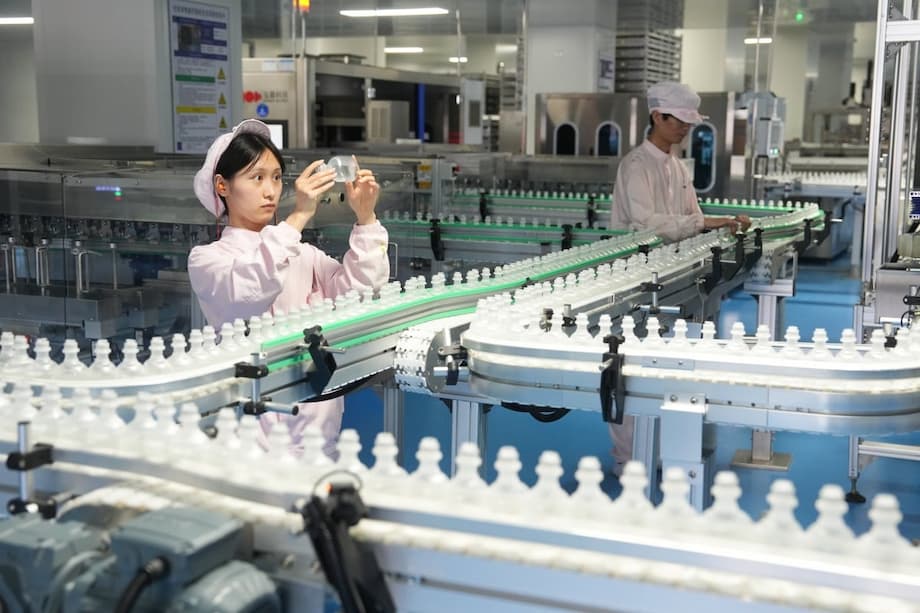China’s Biotech Industry Surges onto the Global Stage
China’s biotechnology sector is undergoing a dramatic transformation, rapidly evolving from a domestic generics powerhouse into a global innovation leader. In recent years, Chinese biotech firms have become central players in the international pharmaceutical landscape, striking multi-billion-dollar deals with Western pharmaceutical giants and reshaping the flow of medical innovation worldwide. This surge is not only redefining China’s role in global healthcare but is also challenging the traditional dominance of the United States and Europe in drug discovery and development.
- China’s Biotech Industry Surges onto the Global Stage
- What Is Driving China’s Biotech Boom?
- Global Pharma Turns to China for Innovation
- How China’s Biotech Model Is Changing
- Challenges and Opportunities in the Global Expansion
- Implications for the Global Pharmaceutical Industry
- Looking Ahead: The Future of China’s Biotech Industry
- In Summary
At the heart of this transformation is a wave of policy support, technological advancement, and strategic partnerships. Chinese Premier Li Qiang recently called for stronger policy backing for the biotech industry, emphasizing the need for original innovation and rapid breakthroughs in core technologies. His remarks, reported by Xinhua News Agency, reflect a national commitment to making biotech a strategic sector vital to both public health and economic growth. As China’s biotech developers sign an increasing number of out-licensing agreements with multinational pharmaceutical companies, the world is taking notice of the country’s newfound prowess in drug development and innovation.
What Is Driving China’s Biotech Boom?
Several factors have converged to propel China’s biotech industry onto the global stage:
- Regulatory Reforms: Since 2015, China’s National Medical Products Administration (NMPA) has overhauled its drug approval process, aligning standards with global norms and dramatically reducing review times. Investigational new drug applications that once took nearly two years now take just a few months, making China an attractive environment for rapid drug development.
- Government Investment and Policy Support: The Chinese government has prioritized biotech in its national development plans, providing funding, infrastructure, and incentives for innovation. AI drug discovery, for example, is now a formal priority in China’s Five-Year Plan for 2025.
- Talent and Expertise: China boasts a deep pool of STEM-educated professionals, many of whom have returned from overseas with experience at leading Western pharmaceutical companies. This talent influx has fueled a culture of innovation and entrepreneurship.
- Cost Advantages: Clinical trials and R&D in China are significantly less expensive than in the West, allowing companies to advance drug candidates more quickly and efficiently.
- Technological Leapfrogging: Chinese biotech firms are leveraging artificial intelligence, automation, and advanced manufacturing to accelerate drug discovery and development, often outpacing traditional methods used elsewhere.
These factors have enabled Chinese companies to move beyond producing generic drugs and active pharmaceutical ingredients (APIs) for export. Today, they are developing first-in-class and best-in-class therapies, particularly in oncology, immunology, and metabolic diseases.
Global Pharma Turns to China for Innovation
One of the most striking trends in recent years is the surge in licensing and acquisition deals between Chinese biotech firms and multinational pharmaceutical companies. In 2024, Chinese biotechs accounted for nearly 32% of global out-licensing deal value, up from 21% in previous years. The number of China-related licensing deals soared from 55 in 2015 to 213 in 2024, with total deal value skyrocketing from $3.1 billion to $57.1 billion.
Major pharmaceutical companies are increasingly sourcing innovative drug candidates from China to replenish their pipelines as patents on blockbuster drugs like Merck’s Keytruda and Novo Nordisk’s Ozempic approach expiration. According to a Nature analysis, 31% of major pharma companies’ innovative pipeline assets in 2024 were in-licensed from China. The combined value of upfront payments, near-term milestones, and equity investments in China-to-West deals reached $8.4 billion in 2024, exceeding the $4.2 billion raised by China-based biotech companies in the private market that year.
Notable recent deals include:
- Pfizer’s $1.25 billion upfront payment to 3SBio for rights to a promising anti-tumor drug, with the total agreement potentially reaching $6.05 billion.
- BioNTech and Bristol Myers Squibb’s $1.5 billion deal for a therapy acquired from Chinese startup Biotheus.
- AstraZeneca’s $1 billion partnership with Gracell Biotechnologies for CAR-T cell therapy technology.
- Merck’s $700 million agreement with Curon Biopharmaceutical to develop T-cell engager technology.
These mega-deals are not just financial transactions; they represent a fundamental shift in how global pharmaceutical companies view Chinese innovation. As one industry analyst put it,
“These trends indicate that China’s influence on the global pharma industry is likely to deepen in the coming years.”
— BioSpace, January 2025
Why Are Western Companies Eager to Partner with China?
There are several reasons why Western pharmaceutical giants are increasingly turning to China for new drug candidates:
- Speed and Cost: Chinese companies can conduct clinical trials faster and at lower cost, allowing them to bring promising assets to the table earlier in development.
- Innovation in Oncology and Biologics: China now leads the world in oncology clinical trials, accounting for 39% of the global total. The country is also at the forefront of developing complex biologics, such as antibody-drug conjugates and bispecific antibodies.
- AI-Driven Drug Discovery: Chinese startups like XtalPi and Insilico Medicine are pioneering the use of artificial intelligence and automation in drug discovery, attracting major deals with companies like AstraZeneca, Pfizer, and Sanofi.
- Regulatory Integration: Since joining the International Council for Harmonisation in 2017, China has become more integrated into the global drug regulatory system, making its clinical data more acceptable to Western regulators.
For Western companies facing a “patent cliff” and rising R&D costs, licensing innovative assets from China offers a cost-effective way to replenish their pipelines and maintain competitiveness.
How China’s Biotech Model Is Changing
Chinese biotech firms have traditionally relied on out-licensing deals—selling the rights to drug candidates that have completed early-stage trials in China to global partners. This model helps ease financial pressures in an industry where new therapeutic approaches are expensive and risky. With China’s healthcare system largely government-funded and domestic drug prices kept low by national insurance schemes, international deals have become a vital source of revenue and validation.
However, the industry is now experimenting with new partnership structures. One emerging trend is the “NewCo” model, where Chinese firms establish overseas entities to house specific pipeline assets. These NewCos raise global capital, oversee clinical development, and allow Chinese companies to retain equity and decision-making influence. This approach enables early-stage assets to enter global markets more quickly and supports diversified revenue streams.
According to China Daily, at least 13 NewCo transactions had been completed by Chinese companies by the first quarter of 2025, with a cumulative value exceeding $10 billion. This model is expected to become a key strategy for Chinese innovative drugs expanding overseas.
From “Me-Too” to “First-in-Class” Innovation
China’s biotech sector has undergone a profound shift from producing “me-too” drugs—copies of existing therapies—to developing “first-in-class” and “best-in-class” medicines. The focus has moved to well-validated targets, such as PD-1/VEGF bispecific antibodies for cancer, but there is growing ambition to pioneer entirely new therapeutic approaches.
The “DeepSeek moment,” as described by industry insiders, refers to the point where domestic Chinese innovation meets global relevance. Akeso Biopharma’s Ivonescimab, for example, outperformed Merck’s Keytruda in clinical trials, igniting a global race for Chinese-developed PD-1/VEGF candidates. This success has spurred a capital market frenzy and a rush of multinational partnerships.
As a result, Chinese biopharma companies are now actively courted by global firms, and licensing revenue in 2024 outpaced total equity fundraising for the sector. Companies like BeiGene and Innovent Biologics are showing signs of financial stabilization, posting profits and increased revenues after years of market downturns.
Challenges and Opportunities in the Global Expansion
Despite the remarkable progress, China’s biotech industry faces several challenges as it expands globally:
- Regulatory Hurdles: While Chinese clinical data is increasingly accepted by Western regulators, there are still concerns about trial diversity and data quality. For example, Eli Lilly’s attempt to bring Tyvyt, a cancer drug developed in China, to the U.S. market was unsuccessful due to lack of global trial data.
- Geopolitical Tensions: U.S. policymakers have introduced measures like the BIOSECURE Act targeting certain Chinese firms, raising uncertainty about future collaborations. However, deal activity continues, with U.S. companies still licensing drugs from China.
- Funding Pressures: Private investment in China’s biotech sector has declined, with 2024 levels just 28% of those in 2021. Tighter IPO regulations and sluggish equity markets have made global partnerships even more critical for Chinese startups.
- Competition and Industry Shakeout: The rush for global deals is intensifying competition among Chinese biotechs. Only a minority of firms are able to secure major partnerships, and the sector is undergoing a structural overhaul focused on developing globally competitive drugs.
Nevertheless, the opportunities are immense. China’s large patient pool and national health insurance system provide vast training sets for AI models, while the country’s deep pool of chemistry and AI engineers supports ongoing innovation. Tech giants like Tencent, Baidu, Alibaba, and ByteDance are investing in biotech startups, further fueling the sector’s growth.
Case Study: Henlius Biotech’s International Licensing
Shanghai Henlius Biotech recently announced a strategic collaboration with GeneQuantum Healthcare and UK-based Envision Pharma for the development and commercialization of GQ1005, an innovative HER2-targeted antibody-drug conjugate for breast cancer. This deal, which covers China and certain overseas markets, exemplifies the new wave of international partnerships that are expanding the reach of Chinese-developed therapies.
Such collaborations not only bring innovative medicines to patients worldwide but also strengthen China’s leadership in fields like oncology, where the country now leads in clinical trial activity.
Implications for the Global Pharmaceutical Industry
The rise of China’s biotech sector is having far-reaching implications for the global pharmaceutical industry:
- Pipeline Replenishment: As patents on blockbuster drugs expire, Western pharmaceutical companies are increasingly looking to China for new assets to fill their pipelines.
- Cost Efficiency: Licensing drugs and accessing advanced AI platforms from Chinese firms is often more affordable than developing new therapies from scratch in the West.
- Shift in Innovation Centers: China’s share of global drug development is rising rapidly. In 2024, the country developed over 1,250 new drugs, outpacing Europe and nearly matching the U.S. output of 1,440 drugs.
- Changing Perceptions: Once seen as a source of low-cost generics, China is now recognized as a hub of cutting-edge innovation, particularly in oncology and AI-driven drug discovery.
- Strategic Partnerships: The NewCo model and other partnership structures are enabling Chinese firms to retain influence over their assets while accessing global markets and capital.
As the global prescription drug market is projected to grow from $1.23 trillion in 2024 to $2.45 trillion by 2032, China’s role as an innovation engine will only become more prominent. Regulatory agencies like the U.S. FDA and European EMA are fast-tracking more Chinese drug approvals, and multinational companies are investing heavily in Chinese innovations.
Looking Ahead: The Future of China’s Biotech Industry
China’s biotech boom is the result of coordinated long-term strategies, regulatory reforms, and a relentless focus on innovation. The sector’s internationalization is accelerating, with more companies launching multiregional clinical trials and adopting partnership models that allow them to compete globally.
Industry experts predict that China’s influence on global pharma will deepen in the coming years, especially as Western companies face mounting pressure to innovate and control costs. The competition for medical innovation is intensifying, and proactive engagement with China’s biotech sector is becoming a necessity for global industry players.
However, the path forward is not without risks. Regulatory alignment, intellectual property protection, and geopolitical tensions will continue to shape the landscape. For Chinese firms, the challenge will be to maintain the pace of innovation, secure global partnerships, and navigate the complexities of international markets.
For now, the momentum is unmistakable: China’s biotech industry is not just catching up—it is setting the pace for the next era of global pharmaceutical innovation.
In Summary
- China’s biotech sector has rapidly evolved into a global innovation leader, driven by regulatory reforms, government support, and technological advancement.
- Chinese firms are striking multi-billion-dollar licensing and acquisition deals with Western pharmaceutical giants, particularly in oncology and AI-driven drug discovery.
- Out-licensing and new partnership models like NewCos are enabling Chinese companies to access global markets and capital while retaining influence over their assets.
- Western pharmaceutical companies are increasingly sourcing innovative drug candidates from China to replenish pipelines and control costs as patents expire.
- Challenges remain, including regulatory hurdles, funding pressures, and geopolitical tensions, but China’s influence on global pharma is expected to deepen in the coming years.
- The sector’s transformation is reshaping the global pharmaceutical industry, with China now recognized as a hub of cutting-edge medical innovation.












